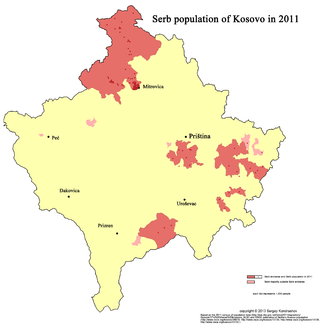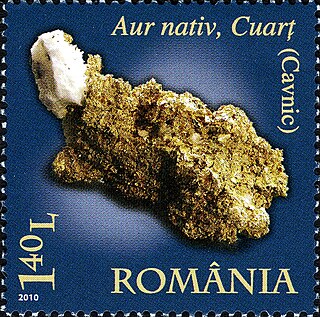Related Research Articles

Serb enclaves are settlements in Kosovo outside North Kosovo where Serbs form a majority.

Novo Brdo or Novobërda and Artanë, is a town and municipality located in the Prishtina district of Kosovo. According to the 2011 census, it has a population of 6,729 inhabitants. The center of the municipality is the village of Bostane. The region is especially known for its role in mining during medieval times, in particular after the construction of the Novo Brdo Fortress by Stefan Milutin to house Saxon miners who were brought in the region.

Leposavić, also known as Leposaviq or Albanik, is a town and the northernmost municipality in the Mitrovica District in Kosovo. As of 2015, it has an estimated population of 18,600 inhabitants. The municipality covers an area of 539 km2 (208 sq mi) which makes it the fifth largest in Kosovo, and consists of the town and 72 villages.

The economy of Kosovo is a transition economy. Kosovo was the poorest province of the former Yugoslavia with a modern economy established only after a series of federal development subsidies in the 1960s and the 1970s.

The Trepča Mines is a large industrial complex in Kosovo, located 9 km (5.6 mi) northeast of Mitrovica. The mine is located on the southern slopes of the Kopaonik mountain, between the peaks of Crni Vrh and Majdan 1,268 m (4,160 ft), and it is Europe's largest lead-zinc and silver ore mine.

The Cavnic mine is a large mine located in the northwest of Romania in Maramureș County, 26 km southwest of Baia Mare and 576 km north of the capital, Bucharest. Cavnic represents one of the largest polymetallic reserves in Romania having significant reserves of gold, silver, copper, lead and zinc amounting to 20 million tonnes of ore grading 1g/t gold, 30g/t silver, 2% lead, 3% zinc and 1% copper. The resources amount to 640,000 oz of gold, 19.2 million oz of silver, 400,000 tonnes of lead metal, 600,000 tonnes of zinc metal, and 200,000 tonnes of copper metal.
The Belo Brdo mine is one of the largest lead and zinc mines in Kosovo The mine is located in Leposavić. The mine has reserves amounting to 1.34 million tonnes of ore grading 6.59% lead, 5.74% zinc and 97.4gr/t silver thus resulting 88,300 tonnes of lead, 77,000 tonnes of zinc and 131 tonnes of silver.
The Crnac mine is one of the largest lead and zinc mines in Kosovo. The mine is located in Leposavić. The mine has reserves amounting to 1.648 million tonnes of ore grading 7.57% lead, 2.93% zinc and 102gr/t silver thus resulting 125,000 tonnes of lead, 48,300 tonnes of zinc and 168 tonnes of silver.
The Stari Trg mine is one of the largest lead and zinc mines in Kosovo. The mine is located in Mitrovicë. The mine has reserves amounting to 0.432 million tonnes of ore grading 5.1% lead, 2.21% zinc and 80.5gr/t silver thus resulting 22,000 tonnes of lead, 9,600 tonnes of zinc and 35 tonnes of silver. The 1989 Kosovo miners' strike took place and ended in the mine, and spread to the entire Kosovo as a general strike. In order to stop the strike, turning into an open unrest, the Yugoslav government decided to impose martial law in the region.
The Hajvalia Mine is one of the largest lead and zinc mines in Kosovo. The mine has reserves amounting to 0.723 million tonnes of ore grading 9.65% lead, 18.26% zinc, and 126.4gr/t silver, thus resulting 69800 tonnes of lead, 132000 tonnes of zinc and 91 tonnes of silver.
The Drazhnje mine is one of the largest lead and zinc mines in Kosovo. The mine is located in Leposavić. The mine has reserves amounting to 6.7 million tonnes of ore grading 2.8% lead, 5.35% zinc and 45gr/t silver thus resulting 187,600 tonnes of lead, 358,500 tonnes of zinc and 302 tonnes of silver.
The Crepulje mine is one of the largest lead and zinc mines in Kosovo. The mine is located in Leposavić. The mine has reserves amounting to 14 million tonnes of ore grading 2.17% lead and 20.07% zinc thus resulting 303,800 tonnes of lead and 2,810,000 tonnes of zinc.
The Sanjak of Viçitrina, also known as the Pristina Pashaluk, was a sanjak of the Ottoman Empire in Rumelia, in present-day Kosovo. It was named after its administrative center Vučitrn.
Natural resources are abundant in Kosovo. Kosovo is mainly rich in lignite and mineral resources such as: coal, zinc, lead, silver and chromium, but also with productive agricultural land. Kosovo is also rich in forests, rivers, mountains and soil; Kosovo is especially rich in coal, being aligned among European countries as the third with the largest coal reserves. Kosovo possesses around 14,700 billion tons of lignite in reserves, which aligns Kosovo as the country with the fifth largest lignite reserves in the world.

Novo Brdo Fortress is a medieval Serbian fortress in Kosovo. Its ruins are located near the town of Novo Brdo, about 40 kilometres (25 mi) east of Pristina. The fortress was built in the late 13th century by king Stephen Uroš II Milutin of Serbia to protect gold, silver, iron and lead mines which were abundant throughout the area. Novo Brdo was famous for its silver. Together with the castles of Prizren, 12 kilometres (7.5 mi) to the southwest, and Prilepac, 13 kilometres (8.1 mi) to the southeast, which guard access roads to the fortress, Novo Brdo helped form a defensive complex overlooking the lucrative mining operations. Novo Brdo was at its height during the Serbian Despotate (1402–1459), when it was the most important mining area and second most important town in Serbia. A significant number of Saxon miners, Albanian Catholics and a large Ragusan merchant colony lived within the town, which was ruled by a vojvoda, but also a governor (kefalija), because it was the seat of an administrative unit of the Despotate.
The Kišnica mine is one of the largest lead and zinc mines in Kosovo. The mine is located in Novo Brdo in Pristina district. The mine has reserves amounting to 10.3 million tonnes of ore grading 3.77% lead, 1% zinc and 47gr/t silver thus resulting 390,000 tonnes of lead, 103,300 tonnes of zinc and 17 million oz of silver.

Kosovo has a slowly developing plain industry. In 2009, the Industry accounted for 22.60 of GDP and a general workforce of 800,000 employees. It's on 150 th place, compared to the rest of the world. There are numerous reasons for this kind of stagnation, ranging from consecutive occupations, political turmoil and the recent Kosovo War (1999).

The siege of Novo Brdo was a military blockade of Novo Brdo, an important fortified mining town in the Serbian Despotate, by the forces of the Ottoman Empire. The siege began in 1440 and lasted until the capture of the fortress on 27 June 1441. During the siege, the Serbian garrison was supported by the local community of citizens of the Republic of Ragusa.

Zinc mining in the United States produced 780,000 tonnes of zinc in 2019, making it the world's fourth-largest zinc producer, after China, Australia, and Peru. Most US zinc came from the Red Dog mine in Alaska. The industry employed about 2,500 in mining and milling, and 250 in smelting.
References
- 1 2 3 "Kosovo Mining Journal" (PDF). beak.de. 2010. Archived from the original (PDF) on 2011-07-18. Retrieved 2010-10-03.